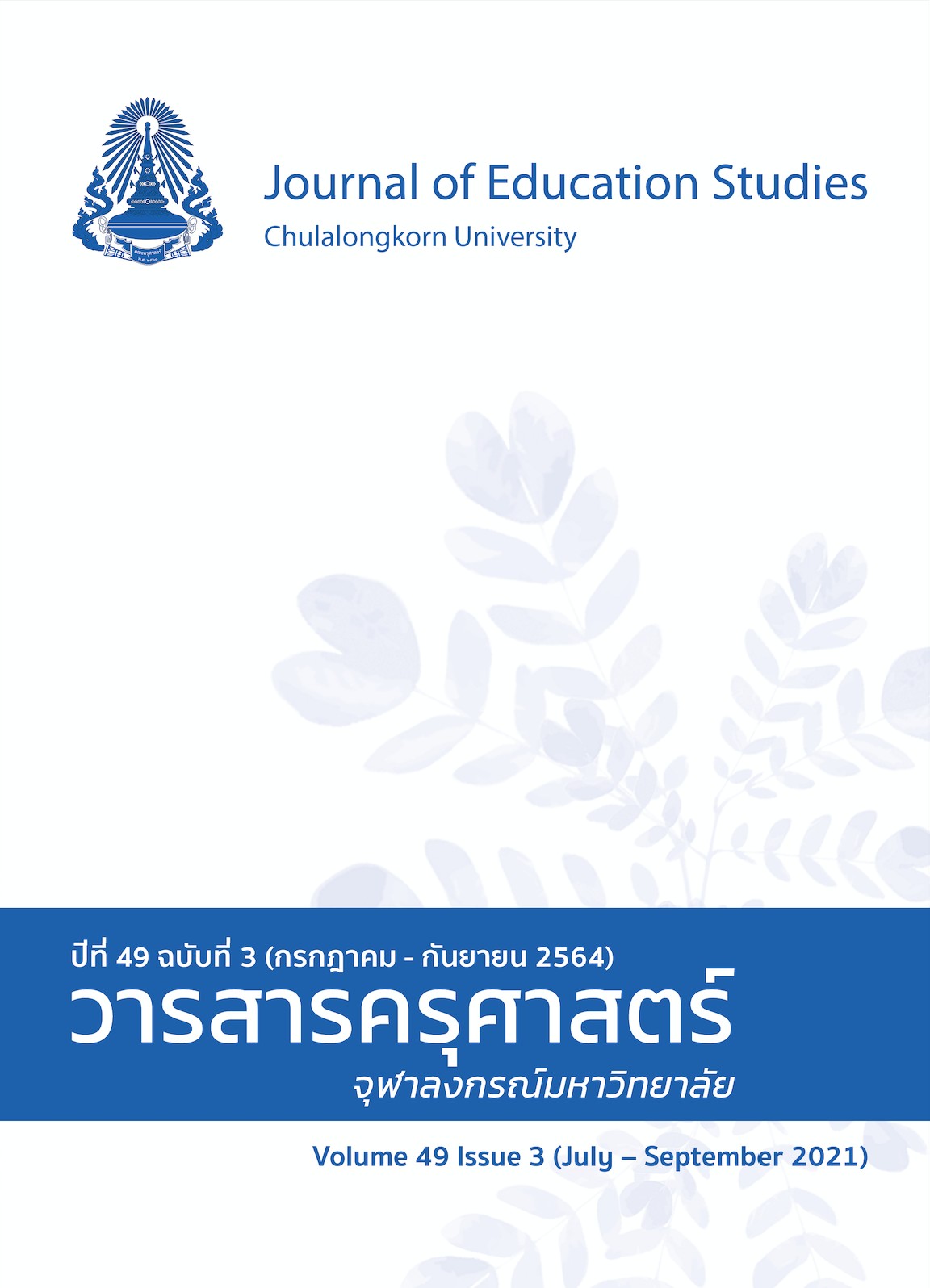The Application of Self-Assessment and Reflection on Developing the Quality of Lesson Plans of English Language Teachers
DOI:
https://doi.org/10.14456/educu.2021.45Keywords:
lesson plan, self-assessment, reflection, English language teacherAbstract
Developing lesson plans is one of the important jobs of teachers in an educational institution. The first step in creating a plan is designing a lesson plan. After the plan is approved by the head of the department or the school principal, it can be applied in teaching and learning instruction. The teachers who apply the plan get records of their teaching, along with any problems found in their classes, which can be used as data in revising the plans. However, there are some issues that need to be refined, specially approaches and tools, which are essential for the development of the plans in this part. Accordingly, this article aims at introducing an application of self-assessment and reflection on developing the quality of lesson plans. The application not only helps increase an understanding among teachers on how to design and create effective clear lesson plans but also encourages teachers to apply self-assessment and reflection in examining and reviewing their works to foster professional development.
References
จุฬินฑิพา นพคุณ.(2561). การสะท้อนความคิดผ่านสมุดบันทึกภาพของนักศึกษาสาขาวิชาการศึกษาปฐมวัย
มหาวิทยาลัยสวนดุสิต. วารสารวิชาการบัณฑิตวิทยาลัยสวนดุสิต, 14(3), 307-321.
ชัชชรีย์ บุนนาค. (2561). ปัญหาการเรียนการสอนภาษาอังกฤษในประเทศไทย และข้อเสนอแนะด้านยุทธศาสตร์
การพัฒนาการเรียนการสอนภาษาอังกฤษ ปี 2564-2568. ใน ดวงสมร รุ่งสวรรค์โพธิ์ (บ.ก.), การประชุม
วิชาการเสนอผลงานวิจัยระดับชาติ ครั้งที่ 2 (น. 235-241). บัณฑิตวิทยาลัย มหาวิทยาลัยราชภัฏสวนสุนันทา.
สำนักงานคณะกรรมการการศึกษาขั้นพื้นฐาน. (2557). คู่มือการจัดการเรียนการสอนภาษาอังกฤษแนวใหม่ตาม
กรอบมาตรฐานความสามารถทางภาษาอังกฤษที่เป็นสากล ระดับชั้นมัธยมศึกษา. โรงพิมพ์องค์การสงเคราะห์
ทหารผ่านศึก.
สำนักงานสภาการศึกษา. (2564, 25 มกราคม). ผลการประชุมคณะกรรมการข้าราชการครูและบุคลากรทางการศึกษา
(ก.ค.ศ.).ครั้งที่ 1/2564. https://otepc.go.th/th/content_page/item/3262-1-
อารีรักษ์ มีแจ้ง. (2560). การพัฒนาชุดฝึกอบรมผ่านเว็บเรื่อง การสอนภาษาอังกฤษแบบบูรณาการทักษะสำหรับ
ครูผู้สอนภาษาอังกฤษระดับมัธยมศึกษา. วารสารศึกษาศาสตร์ มหาวิทยาลัยนเรศวร, 19(4), 110-131.
อารีรักษ์ มีแจ้ง. (2563). หน่วยที่ 7 หลักสูตรในระดับการศึกษาขั้นพื้นฐานของประเทศไทย ใน ประมวลสาระ
ชุดวิชา 22762 สารัตถะวิทยาทางการเรียนการสอนภาษาอังกฤษ หน่วยที่ 1-7 (ฉบับปรับปรุงครั้งที่ 1, น. 1-57). สำนักพิมพ์มหาวิทยาลัย
สุโขทัยธรรมาธิราช.
อวยพร เรืองตระกูล และ สุนทรพจน์ ดํารงพานิช. (2551). การประเมินตนเองเพื่อการพัฒนา ใน เติมเต็มความรู้ : รู้คิด รู้ทำ
(น. 1-26). ศูนย์คุณธรรม.
ภาษาอังกฤษ
Ambrose, S. A., Bridges, M. W., DiPietro, M., Lovett, M. C., & Norman, M. K. (2012). How learning work: Seven
research-based principles for smart teaching. Jossey-Bass.
Boud, D. (2003). Enhancing learning through self-assessment. Routledge.
Cantu, D. V.(2015). Applying reflection and self-assessement practices to integrative STEM lessons: A design-
based research study to develop an instrument for elementary practitioners [Unpublished
doctoral dissertation]. Old Dominion University, DOI: 10.25777/jaq8-0263
https://digitalcommons.odu.edu/stemps_etds/60
Darma, S. D., Suwarno, B., & Mulyadi, M. (2018). English teachers’ difficulties in designing a lesson plan
(RPP) based on KTSP (A study on English teachers at vocational high schools in Bengkulu city).
Journal of Applied Linguistics and Literature, 2(1), 1-11. https://doi.org/10.33369/joall.v2i1.5871
Jensen, L. (2001). Planning lessons. In M. Celce-Murcia. (Ed.), Teaching English as a second or foreign
language (3rd ed). (pp. 403-408). Heinle & Heinle.
Johnson, A. P. (2000). It’s time for Madeline Hunter to go: A new look at lesson plan design. Action in
Teacher Education, 22(1), 72-78. http://dx.doi.org/10.1080/01626620.2000.10462994
Jones, S. (2020). Developing a pedagogy of empowerment: Enabling primary school writers to make
meaningful linguistic choices. In H. Chen, D. Myhill, & H. Lewis. (Eds.), Developing writers
across the primary and secondary years: Growing into writing (pp. 154-170). Routledge.
Krulatz, A. (2013). Teaching Norwegian to beginners: Six principles to guide lesson planning. Journal of the
National Council of Less Commonly Taught Languages, 5, 2-14. http://www.ncolctl.org/files/
Teaching-Norwayan-to-Beginers.pdf
Longfield, J. (2015). Reflective teaching lesson planning steps. Teaching Academy, 55.
https://digitalcommons.georgiasouthern.edu/teaching-academy/55
Macalister, J., & Nation, I. S. P. (2020). Language curriculum design (2nd ed.). Routledge.
Nation, I. S. P., & Macalister, J. (2021). Teaching ESL/EFL reading and writing (2nd ed.). Routledge.
Shen, J., Poppink, S., Cui, Y., & Fan, G. (2007). Lesson planning: A practice of professional responsibility and
development. Educational Horizons, 85(4), 248-258. http://www.jstor.org/stable/42923698
Downloads
Published
How to Cite
Issue
Section
License

This work is licensed under a Creative Commons Attribution-NonCommercial-NoDerivatives 4.0 International License.




